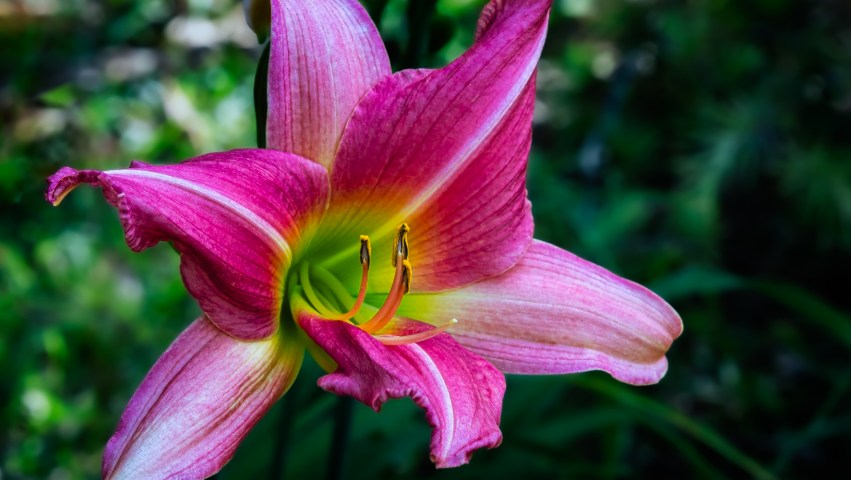From “Hemerocallis” in Flowers and Their Histories by Alice M. Coats:
“There are not very many species of Day-Lily — about thirty in all, including several which are probably only sub-species of the ubiquitous H. fulva, whose range extends from Europe to China. In that flowery land it was cultivated at a very early date, and appears in a painting of the twelfth century; it was called Hsuan T’sao, the Plant of Forgetfulness, because it was supposed to be able to cure sorrow by causing loss of memory….
“In England both H. fulva and H. flava were cultivated before 1597, and called by the early botanists Lilly-Asphodills or Liliasphodelus, because they seemed to embody the characteristics of both families — a lily flower with an asphodel leaf. H. flava, the yellow day-lily or Lemon Lily, ‘is a native of the northern Parts of Europe; it gilds the Meadows of Bohemia; and in Hungary perfumes the Air, in some places for many Miles’. It is very hardy, flourishing even under trees and in towns, and was recommended for London gardens as early as 1722. The foliage is reported to make excellent fodder for cattle, particularly for cows in milk….
“Hemerocallis comes from two Greek words meaning the beauty of the day.”
From “Daylily” in 100 Flowers and How They Got Their Names by Diana Wells:
“The botanical name [hemerocallis] comes from the Greek hemera (day) and kallos (beauty) because the flowers’ beauty lasts but a day, which is also why they are called ‘day lilies.’ They were named by Linnaeus, and the names ‘fulva‘ for the tawny lily and ‘flava‘ for the lemon lily are rare instances where he named specific plants by the color of their flowers.”
From Day Lilies by L. S. Asekoff:
One by one, the unborn
announce themselves — risen from green shadows
day lilies tremble into light.
Hello!
It was only last year that I learned that daylilies are no longer classified as lilies — yet I still associate them with an invented summer time period I call “Lily Season” since they tend to bloom along with true lilies such as Easter Lilies, Madonna Lilies, and the lily-like Amaryllis family’s Swamp Lilies or Crinum. My Lily Season doesn’t have a set start date, though: it starts when I post my first batches of lily and lily-adjacent images, so this year begins on July 6 and will end when I run out of photos. Imaginary seasons can be very flexible.
I took the photos below — along with some of the other varieties I just mentioned, which I’m working on — in the first half of June. They seemed to have bloomed earlier than usual this year, but even though I was iris hunting at the time, I didn’t want to miss them. “Plants behaving strangely” is sort of a theme for gardens and gardening this year (see, for example, Dogwoods with White Blooms (1 of 2)). I’m still puzzling about the lingering effects of a long and unusual deep freeze we had at the end of 2022 — which did a lot of damage to plant life throughout the area — that was followed by a second one a few weeks later that did further damage to plants that were just beginning to recover. Even this late in the year, I see quite a few plants in my own garden that produce new leaves, lose them, then produce another set. I have read elsewhere that some plants — especially struggling shrubs like mine — may need another season to return to their normal cycles, since they’re clearly not dead but not exuberantly alive either.
I’m hoping that there are additional batches of daylilies and true lilies this month, but recurring stormulous weathers have kept me away from the gardens for the past few weeks so I hope my hope is not misplaced.
“Hemerocallis” — the daylily’s genus — is a favorite new word for me, one I only learned when researching their botanical characteristics and history. It looks like a word I might make up, but — alasp! — I did not. Sometimes I holler it to The Dog just because I like how it sounds. And somehow he got it associated with his playtime… so now when I yell “Hemerocallis!” — he runs off and gets his ball…. 🙂
Try this: Let “Hemerocallis” roll off your tongue once or twice the next time you’re out at your favorite speakeasy; it’s sure to impress all your friends!
Or not!
Thanks for taking a look!
























As for my shrubs, “they’re clearly not dead but not exuberantly alive either,” you got it right!
It’s so weird! I have shrubs, groups of ferns, and even some vines that are acting like this. But some are plants I’ve had for 10-15 years, so I hesitate to replace them for at least another year or two since they seem so determined to make their way back.
Thanks for commenting!
I did know that daylilies were not classified as lilies. Nevertheless, I think of them as being lilies. You photographed some beauties.
Thank you!
It was a big surprise to me that I had forgotten what I learned last year… lol! And it is interesting that plants get reclassified as botanists learn more about them — I never knew that before either!